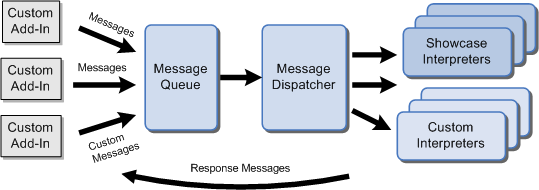The Showcase Message Passing Architecture consists of the Message Queue, a Message Dispatcher and the Showcase Interpreters,
as illustrated in the following diagram. These operate in the larger context of custom add-ins, and the running Showcase application
with loaded scenes and models.
The simplest way to understand the Message Passing Architecture is to follow a Message as it moves through the system:
- The add-in sends a message to Showcase following the established protocol. For example, to trigger a built-in menu item, the
add-in would use the MENU_INVOKE_ITEM Message.
- The Message is automatically placed into the Showcase Message Queue, along with Messages from other add-ins, and Showcase
itself.
- At the beginning of each re-draw, the Message Dispatcher services the queued Messages, passing them to the Showcase interpreters.
Showcase makes use of a number of built-in interpreters, responsible for carrying out the actions indicated in the Messages.
This is transparent to the add-in developer.
- Response Messages flow in the other direction: from Showcase to the add-in. They are used to provide an indication of success
or failure of the task to the add-in.
It is the responsibility of your add-in to listen for Response Messages. Since the Message Passing Architecture is asynchronous
and frame-based, it should not be assumed that an action has been carried out simply because your add-in has issued a Message.
Note the following:
- Messages are serviced by Showcase in the order received by the Message Queue.
- Messages are broadcast to all interpreters (including those instantiated by your own add-ins).
- Messages do not expire. Messages that cannot be serviced by Showcase in one frame are serviced in the next.
- To view Messages in real-time as they are handled by Showcase, run the version of Showcase that includes a console window
(ShowcaseConsole.exe), and load the EchoMessagesCustom.py add-in included in the SDK.
For details see Sending Messages.
Message Types
There are three kinds of Messages:
- Action Messages: These messages instruct Showcase to carry out a specific action.
- Response Messages: These Messages are sent by Showcase to the add-in to indicate its instructions have been carried out.
- Information Messages: Messages that present additional information to the add-in or request additional information from it.
Note Typically, add-ins issue an Action Message, then wait for a Response Message before proceeding. If your add-in issues an
Action Message to delete a scene object, for example, it should wait for confirmation that the object has been deleted before
continuing.
